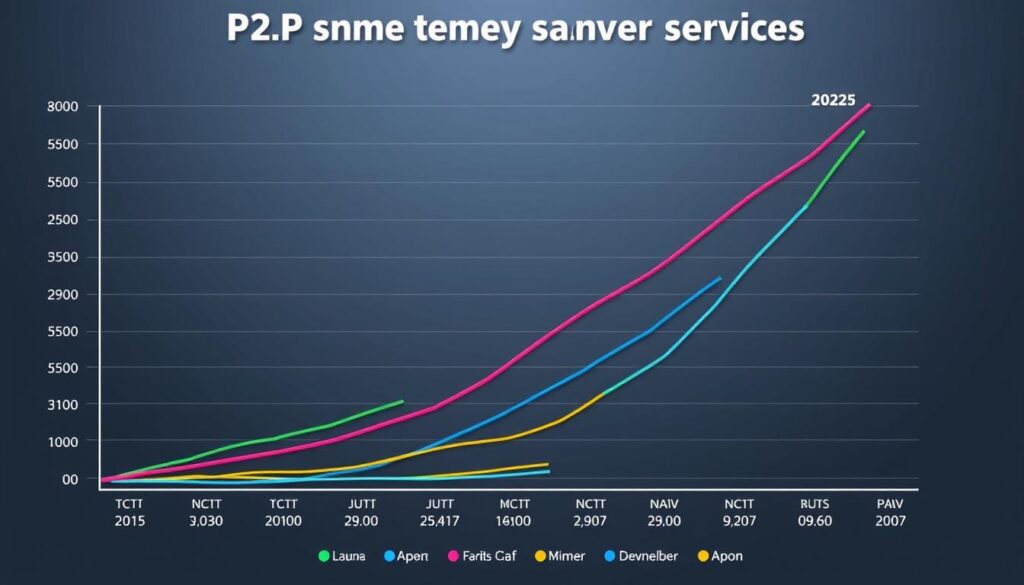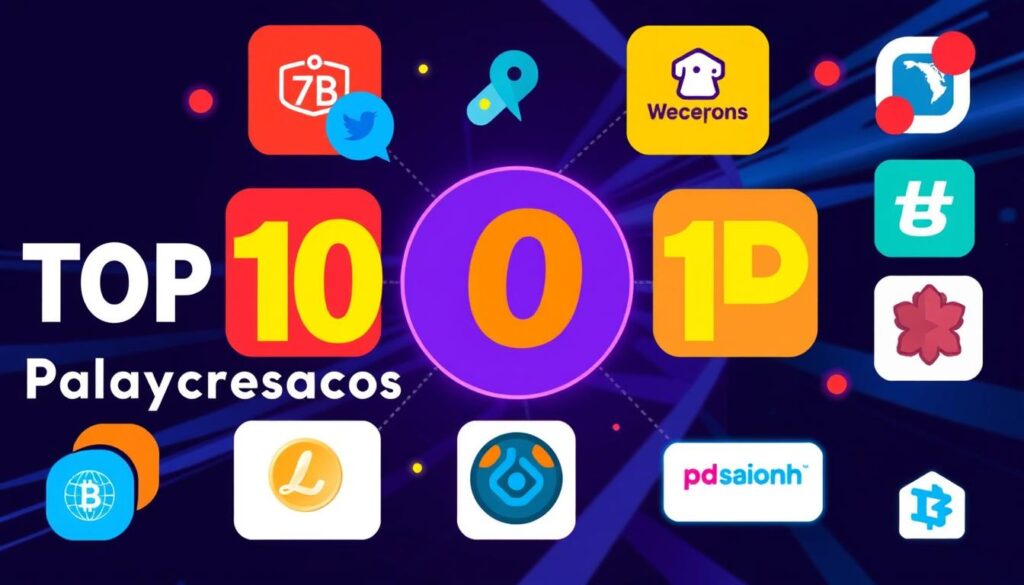Did you know over 2,000 financial institutions now use the Zelle network? This shows how popular peer-to-peer (P2P) money transfer services have become. Digital wallets, mobile payments, and fintech have changed how we handle money. They make sending and getting money faster, easier, and sometimes even free.
In this article, we’ll look at the top 10 peer-to-peer money transfer services. We’ll see what makes them special and how they can help with your money needs.
Key Takeaways
- Peer-to-peer money transfer services let you send money fast and easy to anyone you know.
- They’re getting more popular because they’re quick, easy, and often don’t cost much.
- Services like Zelle, PayPal, Venmo, and Cash App stand out for their unique features and abilities.
- When picking a P2P service, think about things like how much you can send, any fees, how safe it is, and if it works with your bank.
- These services are great for many things, like paying bills, sending gifts, or paying small business expenses.
What Are Peer-to-Peer Money Transfer Services?
Peer-to-peer (P2P) money transfer services let you send money directly to someone else’s bank account or digital payment app. They’ve become very popular because more people use smartphones and want easy ways to send money on the go.
Definition and Overview
P2P payments let you send money from your account to someone else’s. This makes it fast, easy, and safe to send money between people. Often, you can do this in just minutes or seconds.
Rise in Popularity
The P2P money transfer market is growing fast. It’s expected to grow by 18% in 2029 and hit over $9 billion by 2030. This shows a 17.3% compound annual growth rate (CAGR) from 2021 to 2030. This growth is thanks to more people using smartphones and wanting instant, hassle-free money transfers.

Top Players in the P2P Money Transfer Market
The global P2P money transfer market is led by top companies and providers. These companies have become big names in the fast-growing industry. They use their tech, large user bases, and strong brands to lead the market.
Some of the key players in the P2P money transfer market include:
- Tencent
- TransferWise Ltd.
- Alipay
- PayPal Inc.
- Apple Inc.
- Samsung Pay
- Google Inc.
These companies offer a wide range of P2P payment services. They meet the needs of both consumers and businesses. They are at the forefront of the global market.
| Company | Market Share | Key Features |
|---|---|---|
| Tencent | 25% | Integrated with WeChat, China’s leading social media platform |
| TransferWise Ltd. | 15% | Focus on cross-border money transfers with low fees |
| Alipay | 20% | Largest mobile payment platform in China, owned by Alibaba |
| PayPal Inc. | 18% | Global leader in online payment solutions, offering P2P transfers |
| Apple Inc. | 10% | Apple Pay, a popular mobile payment and digital wallet service |
These top p2p money transfer companies and leading peer-to-peer payment providers keep innovating. They are expanding their services. This keeps them as major players in the global p2p money transfer market.

How Peer-to-Peer Money Transfer Works
Peer-to-peer (P2P) money transfer services have made sending and receiving funds easy. With just a few taps on your smartphone, you can send money to friends, family, or anyone you owe. Let’s look at the step-by-step process and common use cases for this handy payment method.
Step-by-Step Guide for Peer-to-Peer Payments
- Download and install the P2P money transfer app of your choice, such as Venmo, Cash App, or Zelle.
- Create an account by providing your personal information and linking your bank account, debit card, or credit card.
- To send money, simply enter the recipient’s name, email, or phone number, the amount you wish to transfer, and a brief description of the payment.
- Review the transaction details and confirm the payment. The money will typically be transferred instantly or within a few business days, depending on the service.
Examples of Peer-to-Peer Money Transfer Use Cases
- Splitting the bill at a restaurant with friends
- Sending money to family members for personal expenses or emergencies
- Paying for goods or services from a local vendor or freelancer
- Reimbursing a colleague for a shared work expense
- Transferring money to a student for their college expenses
With the convenience and speed of peer-to-peer money transfer apps, managing your finances and splitting costs with others is easy. Whether you’re paying your share of the rent or sending a birthday gift, these services make it simple to transfer funds securely and efficiently.

Pros of Using P2P Payment Apps
P2P payment apps have many benefits for those who want to send money easily. Whether it’s sending money to friends and family or splitting bills, these apps are a popular choice. They’re expected to handle a huge $8,563 billion in transactions by 2022.
One big plus of using these apps is how fast you can send and receive money. Unlike old-school banking, P2P apps are quick, often taking just minutes to process. Plus, they work great on both Android and iOS devices, making them easy for many to use.
Another great thing about P2P apps is they might offer better currency exchange rates than banks. This can save you a lot, especially when sending money across borders. Plus, many P2P apps don’t charge much or anything at all for transactions, which is great for your wallet.
Lastly, why use p2p payment apps is their strong security features. They work hard to stop fraud and keep your money safe. With top-notch fraud detection and secure user checks, you can trust that your financial info is safe and private.
“Over 180 billion individuals are expected to partake in P2P transactions by the year 2026, highlighting the growing demand for these convenient and cost-effective payment solutions.”
In summary, the benefits of using peer-to-peer payment apps are clear. They offer a fast, secure way to handle your money. As more people see the value in these apps, they’re set to be a big part of our digital financial future.
Cons of Using P2P Payment Apps
P2P payment apps make sending money easy and modern. But, they also have risks and drawbacks. Users should know about these issues before using them.
Potential Risks and Drawbacks
One big issue with peer-to-peer payment apps is transaction fees. Some apps don’t charge fees, but others can take up to 3% of what you send. Also, the unpredictability of currency exchange rates can change the value of your money.
It can be hard to get refunds or solve problems with P2P transactions. These apps often don’t have strong ways to fix disputes. This leaves users open to errors or fraud.
- There’s a chance of human errors, like sending money to the wrong person. This can cause trouble and make it hard to get your money back.
- The risk of fraud and security threats is big. P2P apps are easy targets for hackers because they have access to your financial info.
- There are also privacy and data usage concerns. Some apps might use your personal info in ways you don’t like.
Peer-to-peer payment apps are great for saving money and being convenient. But, it’s important to think about the risks of p2p money transfer services and potential issues with p2p payment apps before using them a lot. Knowing the drawbacks of using peer-to-peer payment apps helps you make smart choices and avoid risks.
Peer-to-Peer Money Transfer Services
Peer-to-peer (P2P) money transfer services have changed how we send and receive money. They let users quickly and safely move money to friends, family, or businesses. You don’t always need a bank in the middle. Let’s explore some top zelle peer-to-peer payment service, paypal peer-to-peer transfer, venmo peer-to-peer money transfer, and cash app peer-to-peer transfer options.
Zelle
Zelle is a favorite P2P payment service found in many U.S. banks’ mobile apps. It lets users send and receive money fast and safely, often in minutes, by linking bank accounts. Over 2,100 banks and credit unions offer Zelle, making it easy for many people to use.
PayPal
PayPal is a big name in global payments that also offers P2P transfers. You can send and receive money with your PayPal account, bank accounts, or cards. It’s accepted by both people and businesses, making it a good choice for sending money directly.
Venmo
Venmo, owned by PayPal, is a hit with its mobile app for venmo peer-to-peer money transfer. It makes splitting bills and sharing costs easy with friends and family. Venmo is known for its fun features like adding emojis and comments to transactions, especially among the young crowd.
Cash App
Cash App, from Square, is a versatile P2P payment platform. It lets users send, receive, and even invest in cash app peer-to-peer transfer. It’s not just for sending money; you can also buy and sell Bitcoin and trade stocks.
These are some top zelle peer-to-peer payment service, paypal peer-to-peer transfer, venmo peer-to-peer money transfer, and cash app peer-to-peer transfer options out there. As digital payments grow, we have more ways to send money directly to each other safely and easily.
Other Popular P2P Money Transfer Services
Zelle, PayPal, Venmo, and Cash App are big names in P2P money transfer. But, there are others like Apple Pay and Samsung Pay that are also great for sending money between people. They offer more than just P2P transfers.
Apple Pay lets Apple device users send and receive money easily with friends and family. It’s great for those already using Apple products. There are no fees for sending money with a debit card, making it a budget-friendly option.
Samsung Pay is for Samsung device users. It does P2P transfers and offers many ways to pay, like in stores, apps, and online. It’s perfect for those who like Samsung and want one payment solution.
WorldRemit is a top choice for sending money across borders. It has low fees and good exchange rates, making it easy and affordable to send money to over 130 countries. The app and website are easy to use, making it a favorite for sending money to loved ones or businesses overseas.
| Service | Key Features | Fees |
|---|---|---|
| Apple Pay | Peer-to-peer money transfers Seamless integration with Apple ecosystem No fees for debit card transfers | No fees for debit card transfers |
| Samsung Pay | Peer-to-peer money transfers In-store, in-app, and online payments Broad payment options | Varies based on payment method |
| WorldRemit | Cross-border P2P money transfers Low fees and competitive exchange rates Transfers to over 130 countries | Low fees for international transfers |
Looking to send money, pay for something, or transfer funds internationally? These P2P money transfer services have lots to offer. Each one has its own special features and benefits. By knowing what each service offers, you can pick the best one for your needs.
Choosing the Right P2P Money Transfer Service
The P2P money transfer market is growing fast. This means more options for sending money between people. When picking a service, think about how fast it works, how easy it is to use, the exchange rates, and any fees. It’s key to find a service that fits your needs.
By 2026, over 180 million people will use P2P mobile payment apps. This shows how popular these services are becoming. But, the growth is slowing down. This means we need to be smart when choosing a service.
When picking a P2P money transfer service, think about these things:
- Transfer Speed: Some services send money right away. Others might take a few days to get the money into your account.
- Ease of Use: Choose a service that’s easy to use. It should make sending and getting money simple.
- Currency Exchange Rates: If you’re sending money across borders, check the exchange rates. This helps you get the most value.
- Transaction Fees: Some services don’t charge fees, but some might, especially if you use a card.
- Security Features: Look for strong security like multi-factor authentication to keep your money safe.
Also, see if your friends or family use a P2P service. This can make sending money easier within your circle.
By looking at these factors and comparing services, you can pick the best one for you. This ensures a smooth and safe way to send money.
| P2P Service | Transfer Speed | Fees | Security Features |
|---|---|---|---|
| Zelle | Instant | Free | Multi-factor authentication |
| PayPal | Instant or up to 3 business days | Fees for credit/debit card payments | Encryption, fraud protection |
| Venmo | Instant | Free for bank account transfers, fees for credit/debit cards | Two-factor authentication, transaction tracking |
| Cash App | Instant | Free for bank account transfers, fees for credit/debit cards | PIN, biometrics, and transaction monitoring |
Conclusion
Peer-to-peer money transfer services have grown a lot in recent years. Companies like Tencent, TransferWise, Alipay, PayPal, Apple, Samsung, and Google have made these services more popular. They offer fast, secure, and easy ways to send money.
Users love apps like Zelle, PayPal, Venmo, and Cash App for their low fees and quick transactions. These apps also have strong security measures. But, it’s important to know the risks, like data privacy issues and the chance of sending money to the wrong person.
When picking a P2P service, think about how fast it is, the fees, how secure it is, and what you need for your transactions. Knowing the good and bad of each service helps you choose the best one. This way, you can use the key takeaways on p2p payments, the importance of choosing the right p2p money transfer app, and the summary of top peer-to-peer money transfer services to your advantage.
FAQ
What are the best peer-to-peer payment apps?
Some top apps for sending money include Cash App, PayPal, Google Pay, and Apple Cash. These services let you send money fast and often for free.
What is the growth outlook for the peer-to-peer money transfer market?
The market for sending money between people is expected to grow by 18% in 2029. It’s set to make over $9 billion by 2030, growing at a 17.3% annual rate from 2021 to 2030.
Who are the top players in the global P2P money transfer market?
Leading companies in the global P2P money transfer market are Tencent, TransferWise Ltd., Alipay, PayPal Inc., Apple Inc., Samsung Pay, and Google Inc.
How does the peer-to-peer money transfer process work?
Sending money through P2P apps is easy. First, you download the app and set up an account. Then, link your bank account, credit card, or debit card.
To send money, just enter the recipient’s name, the amount, and why you’re sending it. The money usually arrives instantly or within a few days, depending on the service.
What are the pros of using peer-to-peer payment apps?
P2P payment apps let you send and receive money fast. They don’t require cash and often have low or no fees. You can use them on Android and iOS devices.
They might offer better exchange rates than banks. Plus, they have security features to fight fraud and protect your info.
What are the cons and potential risks of using peer-to-peer payment apps?
Using P2P apps has some downsides. Transaction times vary, and there might be fees. Getting refunds or solving disputes can be hard.
There’s a risk of mistakes in transactions and fraud. Currency exchange rates can be unpredictable. Some apps might share your data, which could be a concern.
What are some popular peer-to-peer money transfer services?
Zelle, PayPal, Venmo, and Cash App are some well-known services for sending money. Apple Pay, Samsung Pay, and WorldRemit are also popular choices.
What factors should users consider when choosing a peer-to-peer money transfer service?
When picking a P2P service, think about how fast it works, how easy it is to use, and the exchange rates. Check the fees and see if it has the features you need.
It’s also smart to choose a service your contacts use for easier transactions.



